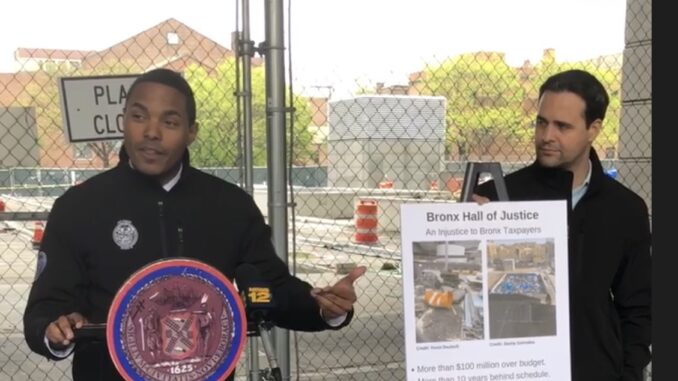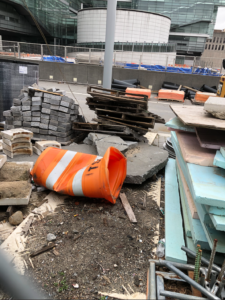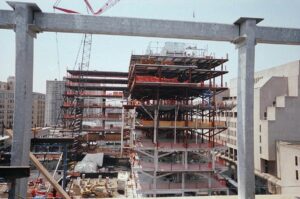
By Kevin Deutsch
[email protected]
Responding to a Bronx Justice News investigation, City Councilman Ritchie Torres has made a referral to the Department of Investigation for an official probe into mismanagement and misuse of taxpayer dollars at the Bronx Hall of Justice—a property plagued by years of government waste, infrastructure problems, and delays.
Raymond Rodriguez, a spokesman for Torres, confirmed the referral to Bronx Justice News last week. The DOI probe, now officially underway, marks the first time a government agency has investigated the troubled courthouse on East 161st Street, which opened three years behind schedule, ran $100 million over budget, and spurred a host of lawsuits involving more than 30 parties, from architects and engineers to construction contractors and state agencies.
Torres, Chair of the Council’s Committee on Oversight and Investigations—which has jurisdiction over DOI—initially vowed to make the referral during a May 3 press conference in front of the courthouse’s still-shuttered civic plaza, a debris-strewn construction site Torres said was indicative of the building’s troubled history.
Design problems and public safety concerns have kept the space from opening, despite millions in ongoing expenditures. Conceived as a symbol of transparency and connectedness with the surrounding community, the plaza-cum-courtyard has instead come to represent a legacy of government waste, poor planning, and infrastructure problems at the property—one of the most expensive taxpayer-funded projects ever completed in the borough.

In response to a Freedom of Information Law filing by Bronx Justice News in May, DASNY—the Dormitory Authority of the State of New York—said this month it could not locate any records showing how much it spent to design and build the civic plaza, despite their having paid more than two dozen contractors to construct the Hall of Justice.
Nor could the agency say how many taxpayer dollars went toward building the property’s rooftop rock garden, which also remains shuttered more than a decade after the courthouse opened.
“The Bronx Hall of Justice has been a profound injustice to the taxpayers of the Bronx,” Torres told reporters at his press conference. “It’s analogous to a shiny apple with a rotten core. Even though the architecture glitters on the surface, the underlying infrastructure has been plagued by a whole host of problems that have come back to haunt the taxpayers of the Bronx.”
The Bronx Justice News investigation, published in April, revealed years of waste and delays at the Hall of Justice, the overall cost of which also remains a mystery. While state officials estimated total design and building costs at about $421 million when the courthouse opened, their FOIL response this month cited the agency’s 2007 Annual Report, which put the project’s cost at about $401 million.
And that’s just one of several dollar totals provided by various groups involved in the project.
The construction manager who completed the building, Hill International, put the project’s value at $450 million. Genesys Engineering, another company involved in building the courthouse, put it at $700 million.
The Hall of Justice is owned and maintained by the city, with the Department of Citywide Administrative Services responsible for day-to-day facilities management. The project’s construction was overseen by the Dormitory Authority. And the city’s Department of Design and Construction is overseeing an ongoing $40 million renovation project to address a host of infrastructure problems at the building, including lack of waterproofing in the courtyard.
Among them: issues with the heating, cooling, and ventilation systems, as well as “conditions that are causing interior glass to break, removal and replacement of defective paint, repair of damaged ductwork in the garage area, and rehabbing of the building’s sewer line and plumbing vent line,” a DDC spokesman recently said.
Construction on the courthouse ran three years behind schedule and $100 million over budget. The lowest-bidding contractor was disqualified because of suspected mob ties, and testing revealed soil at at the construction site to be contaminated with oil, spurring cost overruns and delays.
Just a few years after opening, the Hall of Justice was already involved in a host of lawsuit claims involving more than 30 parties, from government agencies and builders to engineers and contractors. The Dormitory Authority paid out millions of dollars in settlement money, and also recouped some in judgements, records show.

The problems with the courthouse didn’t end there: a construction worker pouring concrete at the construction site was killed, the building’s supposedly bomb-proof glass panels were regularly damaged, and a 75-foot canopy at the courthouse’s entrance was removed after inspectors deemed it unstable. The initial inspectors who improperly signed off on the canopy work were not certified, officials said at the time.
The matter was referred to the Bronx District Attorney’s Office and U.S. Attorney’s Office in 2007, but no charges were ever brought.
The late-2000s saw more problems: Roof leaks, flooding, mold, power outages, and broken elevators and escalators.
The project’s construction manager, Bovis Lend Lease, used numerous contractors at the site. The company, one of the world’s largest construction firms, admitted to a massive over billing scheme on New York projects in 2012–including the Hall of Justice. They were hit with $56 million in fines and restitution fees as a result.
Far from the idyllic civic plaza DCAS assured the public would be open by the end of 2009–complete with evergreen trees, a pedestrian walkway, and outdoor seating—the plaza in April remained a desolate, garbage-strewn construction site, much of it covered in tarp and dust.
The area was quickly cleaned up, and the pace of construction apparently hastened, after Bronx Justice News published its findings.
Sasha Gonzales contributed reporting.
